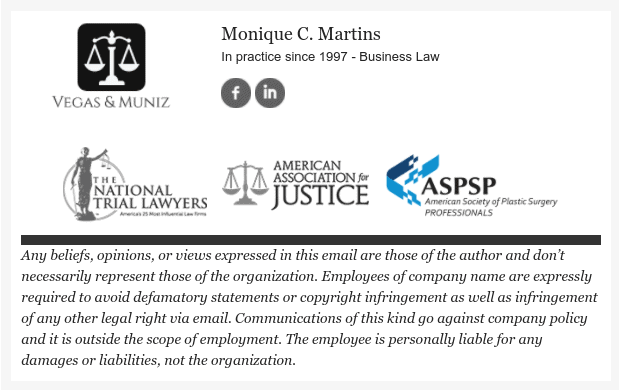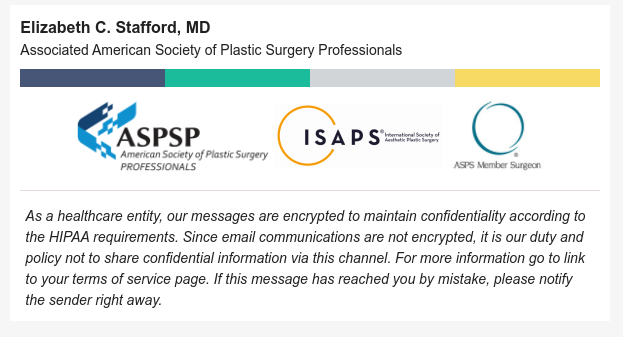This post is also available in: Português
We’ve all seen them, and many of us use them, but how necessary is the large block of text at the bottom of our emails? Email disclaimers are used in a variety of corporate industries in the hopes that the sender will avoid legal consequences in case their email gets into the wrong hands.
While an email disclaimer does not provide you a complete safe haven from legal recourse, it is a valuable tool that, when used in certain business sectors, can provide some protection and potentially save you time, money, and the frustration of fighting certain legal battles.
What is an email disclaimer?
Now that we know that email disclaimers provide value, let’s talk about exactly what they are.
An e-mail disclaimer is a post-script block of text at the bottom of any outgoing email meant to limit liability. The disclaimer typically includes a company’s name, address, and legal registration, along with a confidentiality notice.
Let’s take a look at two examples:
“The information contained in this email and any included attachments are strictly confidential and intended for the specified recipient only. If you received this email in error, please notify the sender promptly and do not disclose of, save or make copies of this email, including the attachments.“
“As a healthcare entity, our messages are encrypted to maintain confidentiality according to the HIPAA requirements. Since email communications are not encrypted, it is our duty and policy not to share confidential information via this channel. For more information visit our terms of service page. If this message has reached you by mistake, please notify the sender right away.“
See also: 8 Effective examples of email signature disclaimers.
Typically, disclaimers are used in conjunction with email signatures. Here we have two examples.
When are disclaimers unnecessary?
Several businesses benefit from the use of email disclaimers, but they are not necessary – or even helpful – in some cases. The use of an email disclaimer is most likely not necessary when communicating in an objective way about items and/or services that you provide.
For example, if in response to an inquiry about your services, you send over a list of services with pricing and an explanation of each service, an email disclaimer is unnecessary. This is information that could likely be sourced online and is therefore not confidential.
Further, when communicating with a customer or client to coordinate meetings, appointments, and events, an email disclaimer is most likely unnecessary. While there are instances where a disclaimer is not helpful, it’s wise to review an email before sending to make sure. When in doubt, don’t leave it out.
When are disclaimers necessary or highly advised?
Certain business sectors have legal regulations in place that require the use of email disclaimers.
- Licensed professionals within the financial services industry have government-regulated disclaimers that need to be included in email communication.
- Registered investment advisors, financial planners, and tax advisors are included in that group.
The CAN-SPAM Act regulates the need for disclaimers when sending marketing emails to customers and clients. The act outlines what a marketing e-mail should and should not include and requires the use of language that provides the recipient the opportunity to opt-out of receiving future emails. This act also makes clear that even if you hire another company to handle your email marketing, you can’t contract away your legal responsibility to comply with the law.
The email communication of health care providers is governed by The Code of Federal Regulations and HIPAA. Health care providers are able to communicate through email so long as they apply reasonable safeguards when doing so.
While not required by law, email disclaimers should be used within the legal industry in an effort to protect confidentiality, assert attorney-client privilege, and to negate the creation of a binding contract. Email disclaimers should also be used when emailing regarding trade secrets or asserting a copyright in the contents of an email. The use of such disclaimers is not a guaranteed protection but does provide a written record of the company’s efforts to protect information included in its outgoing emails.
How should your company implement proper email disclosure policies?
Each business should evaluate their need for an email disclaimer by reviewing the content of emails being sent and whether they need to protect and keep the information confidential.
Based on that evaluation, an email disclaimer should be crafted that pertains directly to the type of information your business sends. This may require that more than one disclaimer is created, and a determination made as to which disclaimer best protects the contents of each email.
If you determine that your business should be using disclaimers for certain outgoing information, craft disclaimers that are clear and easy to understand. Avoiding legalese helps the recipient to quickly read the disclaimer, understand its purpose, and follow up if necessary.
Here is an example of a straightforward, non-legalese disclaimer pertaining to confidentiality that is easy to understand:
“The contents of this email communication and any attachments are confidential. If you are not the intended recipient and have received this email in error, do not use or rely upon the information included. Instead, please inform the sender of the error and delete the email received. Thank you.”
Employees training
Conduct training with your employees regarding the proper use of and need for email disclaimers and provide them with company-created templates. Remind employees to use discretion when sending emails and to double-check the email address of recipients before pressing send.
Employees should also be trained on how to handle a misdirected email and on what the company policy is for ensuring the unintended recipient deletes the information received.
Creation and deployment of email signature disclaimers
If your company needs to create and deploy a disclaimer box for many employees who work daily with email – let’s say 20+ users – then Bybrand’s software may be useful to you in creating HTML disclaimers with links and images.
In these videos, you can see the email signature editor and how to add a disclaimer section.
In the first “A-ha” Moments video, we’ll show you how to add a traditional and two-column disclaimer box to your HTML email signature.
The second video tutorial guides you on how to add an image and links to a disclaimer box in your HTML email signature.
In conclusion
The need for email disclaimers varies among business sectors, but when used appropriately they can be a helpful tool for the protection of your businesses. Take time to research any email disclosure requirements within your industry and craft disclaimers that are clear and straightforward.
Train employees on the proper use of disclaimers and the importance of taking care when sending email communication. Putting these safeguards in place will help to protect your business and the information you send.

Create your first email signature with Bybrand
Bybrand offers the ability to generate, administer, and distribute essential email signatures for your employees.

